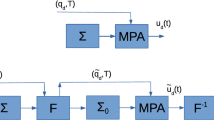Abstract
An approach, motivated by analytical mechanics and linear algebra methods, is proposed for task space decomposition. The approach relies on the introduction of a new set of kinematic parameters describing the constrained motion of the end-effector, using the analytical forms of material and program constraints. These parameters define a new basis in the end-effector configuration space. A general inner product characterized by the unity matrix is introduced in this basis and in its dual, which gives rise to the definition of a new set of metrics for the end-effector configuration space. The vectors defined in these bases are considered as pseudo-orthogonal. Returning to the original bases of the configuration space, the symmetric matrices for the vanishing bilinear forms can be defined. In this way, the freedom and constraint subspaces can be defined in a rigorous, analytical way. The physical meaning of the resulting metrics is explained. It is shown that the task space decomposition is invariant, although non-Euclidean metrics are being used. To illustrate the application of the methodology and to explain further the properties of the task space decomposition, two examples are presented. In the first example, the robot end-effector tracks a planar surface. A particular definition of the program constraint gives rise to the introduction of skewed bases, which better explains the inherent features of the approach. In the second example, a task of operating a planar joystick, with constrained orientation of the end-effector, is considered. The relevant bases of the task space are translated in this case and it is possible to explain other features of the method.
Similar content being viewed by others
Explore related subjects
Discover the latest articles, news and stories from top researchers in related subjects.References
RaibertM. H. and CraigJ. J.: Hybrid position/force control of manipulators, ASME J. Dyn. Syst. Meas. Control 102 (1981), 126–133.
MasonM. T.: Compliance and force control for computer controlled manipulators, IEEE Trans. Syst. Man Cybern. SMC-11, (1981), 418–432.
West, H. and Asada, H.: A method for the design of hybrid position/force controllers for manipulators constrained by contact with the environment, in Proc. IEEE Conf. Rob. Autom., St. Louis, MO, 1985, pp. 251–259.
KhatibO.: A unified approach for motion and force control of robot manipulators: The operational space formulation, IEEE J. Rob. Autom. RA-3 (1987), 43–53.
YoshikawaT.: Dynamic hybrid position/force control of robot manipulators—Description of hand constraints and calculation of joint driving force, IEEE J. Rob. Autom. RA-3 (1987), 386–392.
KankaanrantaR. K. and KoivoH. N.: Dynamics and simulation of compliant motion of a manipulator, IEEE J. Rob. Autom. 4 (1988), 163–173.
McClamrochN. H. and WangD.: Feedback stabilization and tracking of constrained robots, IEEE Trans. Autom. Control 33 (1988), 419–426.
Jankowski, K. P. and ElMaraghy, H. A.: Dynamic control of flexible joint robots with constrained end-effector motion, in Prepr. IFAC Symp. Rob. Control SYROCO'91, Vienna, Austria, 1991, pp. 345–350.
JankowskiK. P. and ElMaraghyH. A.: Dynamic decoupling for hybrid control of rigid-/flexible-joint robots interacting with the environment, IEEE Trans. Rob. Autom. 8 (1992), 519–534.
Jankowski, K. P. and ElMaraghy, H. A.: Inverse dynamics and feedforward controllers for high precision position/force tracking of flexible joint robots, in IEEE Conf. Dec. Control, Tucson, AZ, 1992, pp. 317–322.
LipkinH. and DuffyJ.: Hybrid twist and wrench control for a robotic manipulator, Trans. ASME J. Mech. Transm. Autom. Design 110 (1988), 138–144.
GohbergI., LancasterP., and RodmanL.: Matrices and Indefinite Scalar Products, Birkhäuser, Basel, 1983.
Goldenberg, A. A.: Indefinite inner product-based decomposition and application to control of force and position of robot manipulators, in Proc. IEEE Conf. Rob. Autom., Nice, France, 1992, pp. 1519–1524.
Patterson, T. and Lipkin, H.: Duality of constrained elastic manipulation, in Proc. IEEE Conf. Rob. Autom., Sacramento, CA, 1991, pp. 2820–2825.
Abbati-MarescottiA., BoniventoC., and MelchiorriC.: On the invariance of the hybrid position/force control, J. Intel. Rob. Syst. 3 (1990), 233–250.
DotyK. L., MelchiorriC., and BoniventoC.: A theory of generalized inverses applied to robotics, Int. J. Robotics Res. 12(1) (1993), 1–19.
De Schutter, J. and Bruyninckx, H.: Model-based specification and execution of compliant motion, Tutorial M6, IEEE Conf. Rob. Autom., Nice, France, 1992.
Griffis, M. and Duffy, J.: Notes on kinestatic control: Using displacement to null forces, Tutorial S5, IEEE Conf. Rob. Autom., Atlanta, GA, 1993.
JankowskiK.: Formulation of equations of motion in quasi-velocities for constrained mechanical systems, Mechanism and Machine Theory 23(6) (1988), 441–447.
PapastavridisJ. G.: The Maggi or canonical form of Lagrange's equations of motion of holonomic mechanical systems, Trans. ASME J. Applied Mechanics 57 (1990), 1004–1010.
KurdilaA., PapastavridisJ. G., and KamatM. P.: Role of Maggi's equations in computational methods for constrained multibody systems, J. Guidance 13 (1990), 113–120.
GreubW. H.: Linear Algebra, Springer, Berlin, 1967.
PeaseM. C.: III, Methods of Matrix Algebra, Academic Press, New York, 1965.
BowenR. M. and WangC.-C.: Introduction to Vectors and Tensors, Vol. 1, Plenum Press, New York, 1976.
BoothbyW. M.: An Introduction to Differentiable Manifolds and Riemannian Geometry, Academic Press, Orlando, 1986.
WangC.-C.: Mathematical Principles of Mechanics and Electromagnetism, Plenum Press, New York, 1979.
JankowskiK. P.: Dynamics of controlled mechanical systems with material and program constraints, Parts I–III, Mechanism and Machine Theory 24 (1989), 175–193.
Lončarić, J.: Geometrical analysis of compliant mechanisms in robotics, PhD Dissertation, Harvard University, Cambridge, MA, 1985.
SokolnikoffI. S.: Tensor Analysis, Wiley, New York, 1964.
DuffyJ.: The fallacy of modern hybrid control theory that is based on ‘orthogonal complements’ of twist and wrench spaces, J. Robotic Systems 7 (1990), 139–144.
Author information
Authors and Affiliations
Rights and permissions
About this article
Cite this article
Jankowski, K.P., Elmaraghy, H.A. Task space decomposition for invariant control of constrained robots. J Intell Robot Syst 16, 209–227 (1996). https://doi.org/10.1007/BF00245421
Received:
Accepted:
Issue Date:
DOI: https://doi.org/10.1007/BF00245421




